Good update - both on your actions, your plans and the explanation of the command points system. I do think you need to make a slight edit at the start of your Beginner's Corner, from "In Birth of America, they are three types of land units:" to "In Alea Jacta Est...". 
The Hero, The Traitor and The Barbarian - an AJE PBEM Beginner AAR
- Thread starter Narwhal
- Start date
-
We have updated our Community Code of Conduct. Please read through the new rules for the forum that are an integral part of Paradox Interactive’s User Agreement.
You are using an out of date browser. It may not display this or other websites correctly.
You should upgrade or use an alternative browser.
You should upgrade or use an alternative browser.
Good update - both on your actions, your plans and the explanation of the command points system. I do think you need to make a slight edit at the start of your Beginner's Corner, from "In Birth of America, they are three types of land units:" to "In Alea Jacta Est...".
Good catch. I tried to inspire myself from what I already wrote, but a) proofread me, for once, and b) tried to make it "easier" to understand.
Great to see you two locked up again in an AAR.
I might actually jump into the PBEM mix with this new release.
Thanks.
I might actually jump into the PBEM mix with this new release.
Thanks.
Turn 2 - Populares
Well first up, there is a nasty new mechanic in AJE. Storms. Now this is good simulation as in this era winter travel in the Med was highly dangerous but it is bad as my African force lands in Italy, but now needs to recover for a few terms due to damage at sea. The AGE games have always had at sea attrition, but usually you can recover quickly.
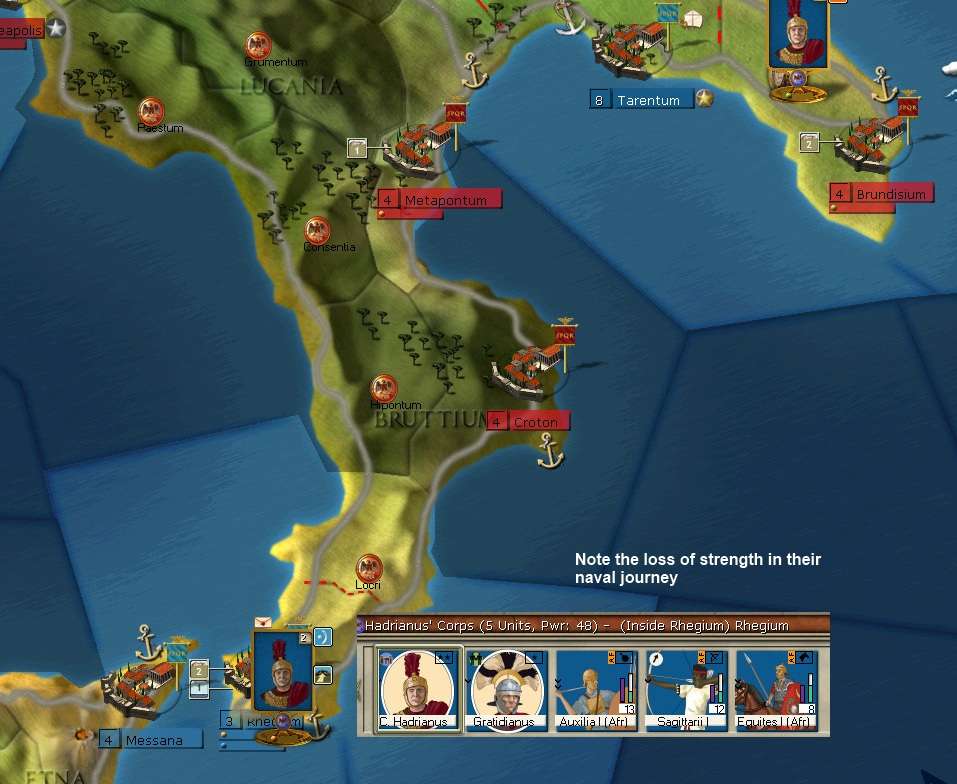
Since at this stage I didn't know about the hidden Nola force I was relatively relaxed about this delay to my carefully constructed, well integrated master plan.
At Capua, Cinna is now interested in making war. Well off to Rome you go.
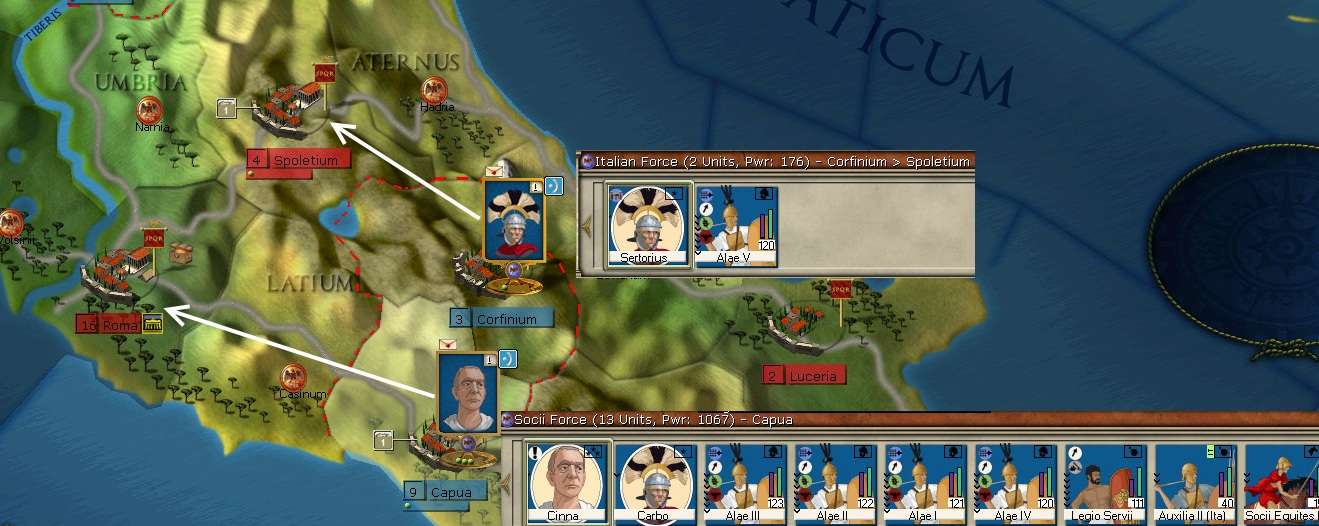
That unit at Corfinium can move to invest Spoletum as I'm trying to clear out as many of these rebel (they are the rebels aren't they?) cities while moving to blockade Ancona
In the meantime Marius moves to Perugia so as to threaten Ancona.
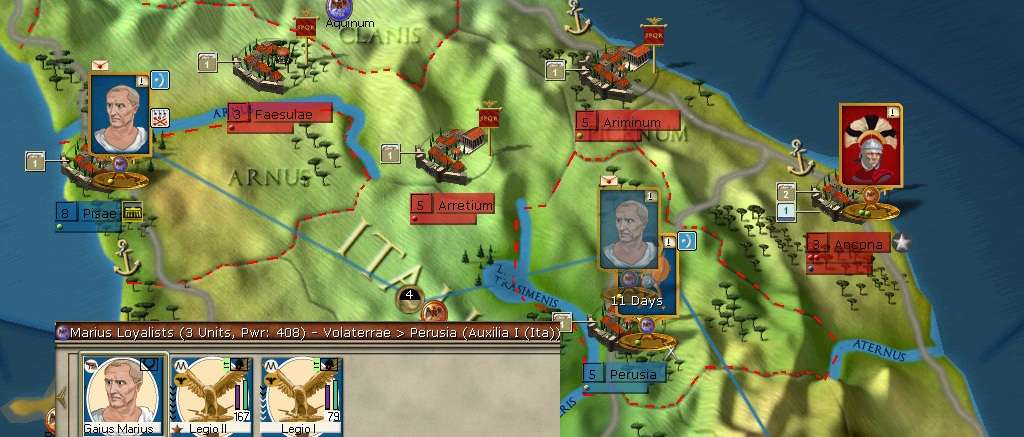
Now in Spain, the Spanish have revolted. This is an act of stunning ingratitude and rather confusing. I mean I am the rebel here?

Anyway that force I left at Ilipia can deal with this minor annoyance
More money sounds really rather good.
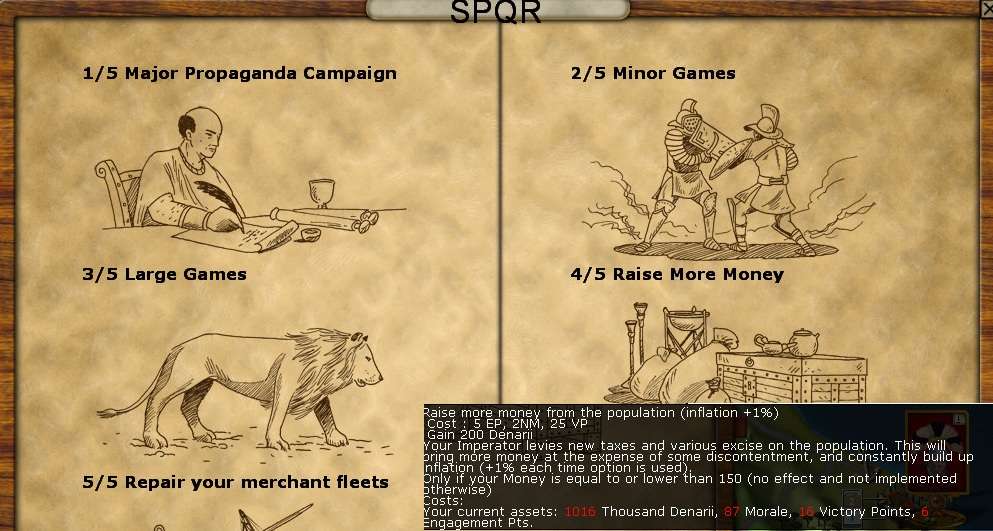
Like PoN and RUS, AJE has lots of decisions you can play. Some are long term like this merchant one. Well my judgement is I need the cash to build up the army I need to win.
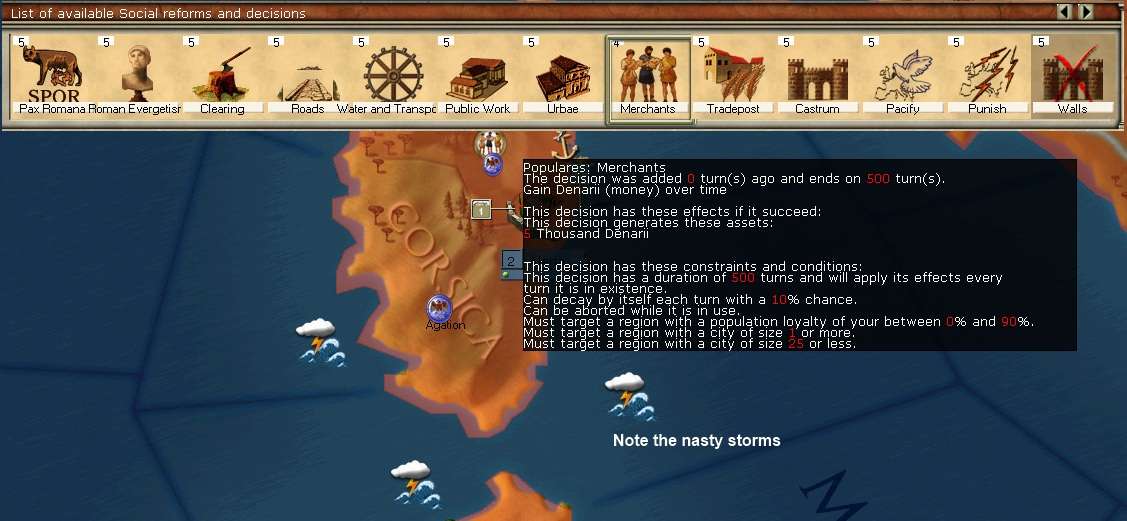
And I raise some more legions. Note that each of the main areas – Italy, Sicily, Spain and Africa have a limited pool. You can also recruit more specialist units from places like the Baleares (slingers).

In this case I opt for 2 new legions and some auxilaries in Northern Italy. Far enough from the combat zone to be safe till they finish trainig, but near enough to contribute to the campaign in Italy when they are ready.
Well first up, there is a nasty new mechanic in AJE. Storms. Now this is good simulation as in this era winter travel in the Med was highly dangerous but it is bad as my African force lands in Italy, but now needs to recover for a few terms due to damage at sea. The AGE games have always had at sea attrition, but usually you can recover quickly.

Since at this stage I didn't know about the hidden Nola force I was relatively relaxed about this delay to my carefully constructed, well integrated master plan.
At Capua, Cinna is now interested in making war. Well off to Rome you go.

That unit at Corfinium can move to invest Spoletum as I'm trying to clear out as many of these rebel (they are the rebels aren't they?) cities while moving to blockade Ancona
In the meantime Marius moves to Perugia so as to threaten Ancona.

Now in Spain, the Spanish have revolted. This is an act of stunning ingratitude and rather confusing. I mean I am the rebel here?

Anyway that force I left at Ilipia can deal with this minor annoyance
More money sounds really rather good.

Like PoN and RUS, AJE has lots of decisions you can play. Some are long term like this merchant one. Well my judgement is I need the cash to build up the army I need to win.

And I raise some more legions. Note that each of the main areas – Italy, Sicily, Spain and Africa have a limited pool. You can also recruit more specialist units from places like the Baleares (slingers).

In this case I opt for 2 new legions and some auxilaries in Northern Italy. Far enough from the combat zone to be safe till they finish trainig, but near enough to contribute to the campaign in Italy when they are ready.
I might actually jump into the PBEM mix with this new release.
More people should, as there's never enough PBEMers.
Oh my goodness. RUS and WIA had a beautiful baby acronym and his name is AJE. I'm interested. Scratch that, committed. Pre-ordered.
I'm really looking forward to this AAR, and seeing your campaign develop! Best of luck, legates.
I'm really looking forward to this AAR, and seeing your campaign develop! Best of luck, legates.
loki100 said:That unit at Corfinium can move to invest Spoletum as I'm trying to clear out as many of these rebel (they are the rebels aren't they?) cities while moving to blockade Ancona.
Now in Spain, the Spanish have revolted. This is an act of stunning ingratitude and rather confusing. I mean I am the rebel here?
Little bit of inconsistency in your standards here, if I may say so.
Overall, it's hard to gauge how you and Narwhal are doing until you actually start to clash with each other, but I will say that so far, so reasonable. Nothing earth-shattering, but you seem to be taking a sensible, measured approach to things.
Yeah it seems likely that Cinna will take Italy while Sulla settles up Greece. I'd be interested to see a later game where one of the players goes for a highly aggressive move and tries to take the other theater, but as is it makes sense to do these moves.
More people should, as there's never enough PBEMers.
Indeed, since most of these scenarios are 3 sided, plus an annoyed AI, the scope for all sorts of underhand tricks in PBEM is huge ... and will hopefully be reflected in AARs :happy:
Oh my goodness. RUS and WIA had a beautiful baby acronym and his name is AJE. I'm interested. Scratch that, committed. Pre-ordered.
I'm really looking forward to this AAR, and seeing your campaign develop! Best of luck, legates.
that is, to me, a good summary of this. We are back to pared down focus of WiA (not least armies are stacked not spread out), with the political element of RUS added in. The 3-3 nature of most scenarios (often with an AI faction lurking too) can only add to the scope. In this one, we are both, pretty early on, having troubles with our respective AI, in fact the AI that Narwhal is meant to be dealing with has invaded Italy, so I am really not sure what he is up to over there :laugh:
Little bit of inconsistency in your standards here, if I may say so.
Overall, it's hard to gauge how you and Narwhal are doing until you actually start to clash with each other, but I will say that so far, so reasonable. Nothing earth-shattering, but you seem to be taking a sensible, measured approach to things.
Well first turn, nearly everything is locked, so this was the first chance to move. But don't worry it will get murky and complex very soon.
The rebels having a rebellion, now that's inception in the game i say!
Yep, I mean what is the world coming to. Its like the threat of Shetland to declare independence if Scotland goes independent ....
Yeah it seems likely that Cinna will take Italy while Sulla settles up Greece. I'd be interested to see a later game where one of the players goes for a highly aggressive move and tries to take the other theater, but as is it makes sense to do these moves.
I think the Italy/Greece opening moves look sensible. I'm developing mine on the fly as I have no idea what is around the corner, I suspect Narwhal has a little bit more knowledge having been in the beta.
But don't worry, neither of us feels the need to respect such old fashioned concepts as 'spheres of influence' for very long. Actually I've just done my orders for turn #6 and it looks like the AI is currently winning
The rebels having a rebellion, now that's inception in the game i say!
Actually, the Lusitanians are more "not yet conquered" people.
Yeah it seems likely that Cinna will take Italy while Sulla settles up Greece. I'd be interested to see a later game where one of the players goes for a highly aggressive move and tries to take the other theater, but as is it makes sense to do these moves.
I am still strong in Italy, trust me. And as I play, I know have a couple POP legions in Greece. And I understand an handful of Pontus troops landed in Sicilia (I cannot see them)
Losing Romes - April 87
The situation, expectedly, ain’t good, as I am losing Romes as I go along.
I lost the second Rome to Pontus, after close to 10 vicious assaults. Here is the first battle :

And most of the defenses of the First Rome are gone – the final Populares assault will be for next month :

On the other hand, my troops in Rome evaded the enemy forces and regrouped in Ancona :

Unfortunately, the Populares are regrouping themselves just nearby. I am going to hold my position for now.
In Greece, there is strong Pontic advance, but at least Thebae surrendered without combat :

I need to act fast, and now I will move to Athenae.

Finally, I received good news from Lucullus :

Two new units of ships. Unfortunately, there is a storm just at the exit of Gortyn, so I will not take all my fleet but just one unit, and I will go toward Cyrene :

This is risky (storms can hit hard) but I have little time !
Now, a couple basic beginner’s corners
Beginner’s corner : Activation
In war, your generals are not machines obeying to each and all of your commands. They can be busy intriguing, they may not understand your orders, they may have troubles getting respected.
In game term, to represent this, each leader can be either “active” or “unactive”. The test is run every turn. Under the most common option (this can be changed in settings) :
- An activated leader behaves normally
- A non-activated leader is sulking, distraught or just play lazy : any army he is leading got a (very significant) malus in speed and attack capacity, and more importantly, cannot be set in an offensive or assault posture (see below).
Activation depends on two main factors :
- the skill of the leader in "strategy",
- whether the leader was already active the previous turn.
To see whether the leader is active or not, look at the envelop ABOVE his portrait : if it is white, he is active. If it is yellow, he is not.
For instance, here is Sulla’s icon on the map :

Sulla is obviously filling some important paperwork, and won’t be assaulting any Greek city this turn.
On the other hand, here is Braetius :

Braetius has done his homeworks, except the MAKING HISTORY one - he is now looking for some action !
Beginner’s corner : Posture and ROE - Basics
As you have seen, I give orders to my troops for the next month. But what happens if my troops meet the enemy ? Do they engage ? Do they flee ? Well, much depends on who is their commander… and what posture (a.k.a. “stance”) and Rule of Engagement (ROE) you gave them.
You control that here :

Posture and ROE are given for the month.
There are 4 postures – here are their simplified description :
- Assault Posture (RED icon): your stack will attack any enemy army it encounters, and assault any structure it finishes its moves on, if it can. If you want to attack every structure on the way of your stack, you also need to set its Rule of Engagement to “All-out assault”.
- Attack Posture (ORANGE icon) : your stack will attack any enemy army it encounters, but not the structures.
- Defensive Posture (BLUE icon) : your stack will not attack any enemy on its own, but it will (usually) block its movements, forcing the opponent to attack if it wants to “pass”. The stack will also fortify, thus increasing its bonus each turn (up to a maximum).
- Passive posture (GREEN icon) : your stack will move out of the way (in another province) if it is in the same province as an enemy army, whatever that other army’s posture is. If it is forced into battle, it will try to retreat ASAP.
Small stacks in Passive posture are very difficult to force into battle.
Remember that if the stack is not activated, you CANNOT choose the Assault or Attack Posture (protip : switch the leader if you can).
That there are two related special orders :
- “Evade Combat” which allows small stacks to avoid combat and enemies without actually “moving out of the way”. Better when used with fast or light units.
- “Ambush” will allow a stack to, well, try to set up an ambush (might fail), i.e. attack the enemy with a high surprise bonus and with the opponent losing its eventual range advantage (for instance, archers vs slingers). Ambushes only work if the stack does not move (i.e. downtown Rome is out).
In term of posture, keep a defensive one when you ambush ; if the ambush is successful, in game term, it will be as if your stack is the one "attacked" (it will keep its entrenchment and other bonus of “defensive” posture, while the opponent will have no defensive bonus at all).
Once the battle has started, you might want to decide whether your army attacks aggressively or not. Those are the Rules of Engagement (ROE). There are 4 of them, with different names depending on your posture :
- All out attack / Hold at all cost : The army will NEVER retreats, whatever the odds are. It can still rout, though. It is to be used VERY carefully, because whole armies can be destroyed because you gave that order at the wrong moment. On attack, “All out attack” will also translate into more losses for everyone, especially you. Finally, “all out attack” + “assault posture” will make your stack assault all the structures it meets.
- Sustained attack / Defend : The “standard attack”. Your leader will take the initiative in retreating if he feels the situation gets… difficult.
- Conservative attack / Defend and Retreat : The army will fight a little, then retreat, except if the leader believes he is clearly winning the battle. Losses will be limited for both sides. Good to use when you are not quite sure of what you will meet.
- Feint attack / Retreat if engaged : Your army will retreat very quickly (Feint attack) or immediately. It can be good to exhaust / slow down and enemy or to scout his forces. “Retreat if engaged” is handy, though.
You can see what posture I selected by looking at the color (and shape) of the icon on the upper right corner of the picture of the general on the map :
This stack for instance has the defensive posture (and if you remember the previous Beginner’s Corner – is active).

The situation, expectedly, ain’t good, as I am losing Romes as I go along.
I lost the second Rome to Pontus, after close to 10 vicious assaults. Here is the first battle :

And most of the defenses of the First Rome are gone – the final Populares assault will be for next month :

On the other hand, my troops in Rome evaded the enemy forces and regrouped in Ancona :

Unfortunately, the Populares are regrouping themselves just nearby. I am going to hold my position for now.
In Greece, there is strong Pontic advance, but at least Thebae surrendered without combat :

I need to act fast, and now I will move to Athenae.

Finally, I received good news from Lucullus :

Two new units of ships. Unfortunately, there is a storm just at the exit of Gortyn, so I will not take all my fleet but just one unit, and I will go toward Cyrene :

This is risky (storms can hit hard) but I have little time !
Now, a couple basic beginner’s corners
Beginner’s corner : Activation
In war, your generals are not machines obeying to each and all of your commands. They can be busy intriguing, they may not understand your orders, they may have troubles getting respected.
In game term, to represent this, each leader can be either “active” or “unactive”. The test is run every turn. Under the most common option (this can be changed in settings) :
- An activated leader behaves normally
- A non-activated leader is sulking, distraught or just play lazy : any army he is leading got a (very significant) malus in speed and attack capacity, and more importantly, cannot be set in an offensive or assault posture (see below).
Activation depends on two main factors :
- the skill of the leader in "strategy",
- whether the leader was already active the previous turn.
To see whether the leader is active or not, look at the envelop ABOVE his portrait : if it is white, he is active. If it is yellow, he is not.
For instance, here is Sulla’s icon on the map :

Sulla is obviously filling some important paperwork, and won’t be assaulting any Greek city this turn.
On the other hand, here is Braetius :

Braetius has done his homeworks, except the MAKING HISTORY one - he is now looking for some action !
Beginner’s corner : Posture and ROE - Basics
As you have seen, I give orders to my troops for the next month. But what happens if my troops meet the enemy ? Do they engage ? Do they flee ? Well, much depends on who is their commander… and what posture (a.k.a. “stance”) and Rule of Engagement (ROE) you gave them.
You control that here :

Posture and ROE are given for the month.
There are 4 postures – here are their simplified description :
- Assault Posture (RED icon): your stack will attack any enemy army it encounters, and assault any structure it finishes its moves on, if it can. If you want to attack every structure on the way of your stack, you also need to set its Rule of Engagement to “All-out assault”.
- Attack Posture (ORANGE icon) : your stack will attack any enemy army it encounters, but not the structures.
- Defensive Posture (BLUE icon) : your stack will not attack any enemy on its own, but it will (usually) block its movements, forcing the opponent to attack if it wants to “pass”. The stack will also fortify, thus increasing its bonus each turn (up to a maximum).
- Passive posture (GREEN icon) : your stack will move out of the way (in another province) if it is in the same province as an enemy army, whatever that other army’s posture is. If it is forced into battle, it will try to retreat ASAP.
Small stacks in Passive posture are very difficult to force into battle.
Remember that if the stack is not activated, you CANNOT choose the Assault or Attack Posture (protip : switch the leader if you can).
That there are two related special orders :
- “Evade Combat” which allows small stacks to avoid combat and enemies without actually “moving out of the way”. Better when used with fast or light units.
- “Ambush” will allow a stack to, well, try to set up an ambush (might fail), i.e. attack the enemy with a high surprise bonus and with the opponent losing its eventual range advantage (for instance, archers vs slingers). Ambushes only work if the stack does not move (i.e. downtown Rome is out).
In term of posture, keep a defensive one when you ambush ; if the ambush is successful, in game term, it will be as if your stack is the one "attacked" (it will keep its entrenchment and other bonus of “defensive” posture, while the opponent will have no defensive bonus at all).
Once the battle has started, you might want to decide whether your army attacks aggressively or not. Those are the Rules of Engagement (ROE). There are 4 of them, with different names depending on your posture :
- All out attack / Hold at all cost : The army will NEVER retreats, whatever the odds are. It can still rout, though. It is to be used VERY carefully, because whole armies can be destroyed because you gave that order at the wrong moment. On attack, “All out attack” will also translate into more losses for everyone, especially you. Finally, “all out attack” + “assault posture” will make your stack assault all the structures it meets.
- Sustained attack / Defend : The “standard attack”. Your leader will take the initiative in retreating if he feels the situation gets… difficult.
- Conservative attack / Defend and Retreat : The army will fight a little, then retreat, except if the leader believes he is clearly winning the battle. Losses will be limited for both sides. Good to use when you are not quite sure of what you will meet.
- Feint attack / Retreat if engaged : Your army will retreat very quickly (Feint attack) or immediately. It can be good to exhaust / slow down and enemy or to scout his forces. “Retreat if engaged” is handy, though.
You can see what posture I selected by looking at the color (and shape) of the icon on the upper right corner of the picture of the general on the map :
This stack for instance has the defensive posture (and if you remember the previous Beginner’s Corner – is active).

Turn 3 - Populares (April 87)
So, lets see where we are (actually under cat attack [1] irl, but that is not modelled in the game).
Well my attempt to relieve Corduba was a total disaster, but at least most of my army survived. They can retreat back to Ilipa and recover.
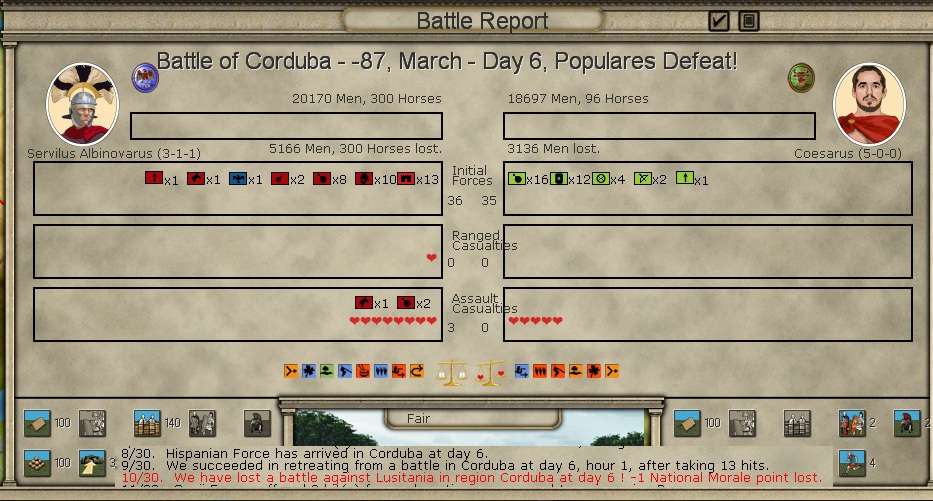

At Rome, Cinna did a decent job but still failed to take the city.
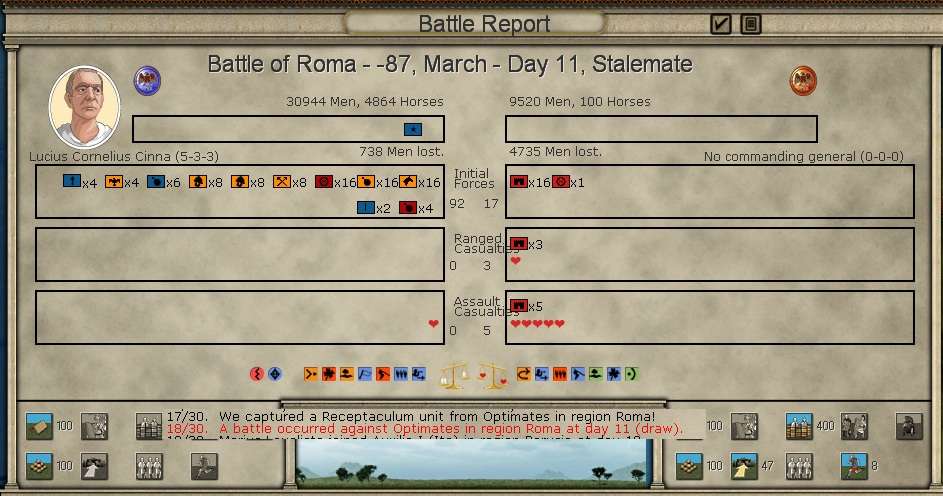
Marius in the meantime is watching the enemy at Ancona. I'll keep on the defense till Cinna has taken Rome.
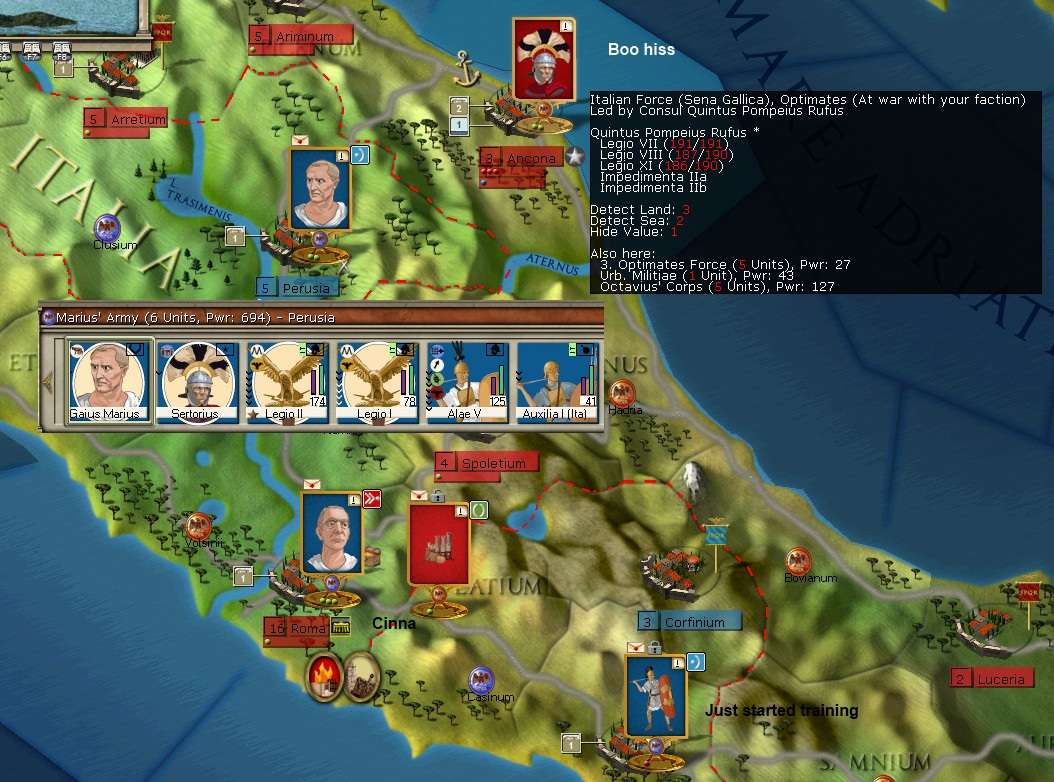
At sea, someone was not paying attention.
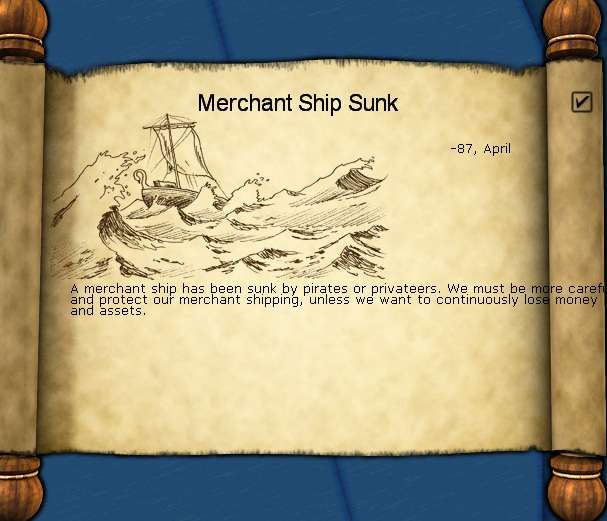
I mean if a ship has a strange black and white flag you do not invite the crew on board for a nice drink and chance to look around.
I decide to buy a supply wagon for the legions besieging Brundisium. That should ensure they can take the city (which is otherwise an easy route back into Italy for Sulla)
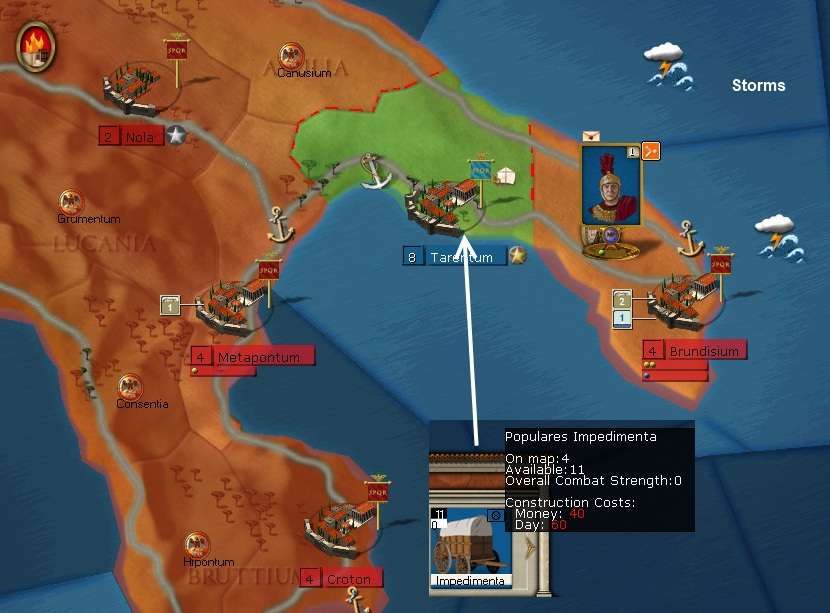
And, yep, we'll have some more money thank you.
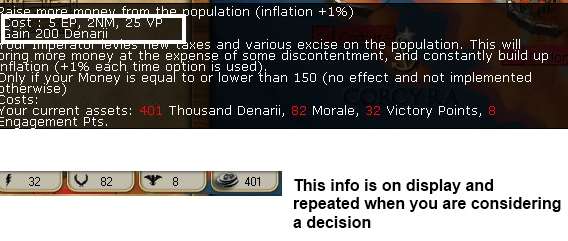
And lets have a look at the 'decisions'. Subversion sounds fun, lets try some of that over in Greece
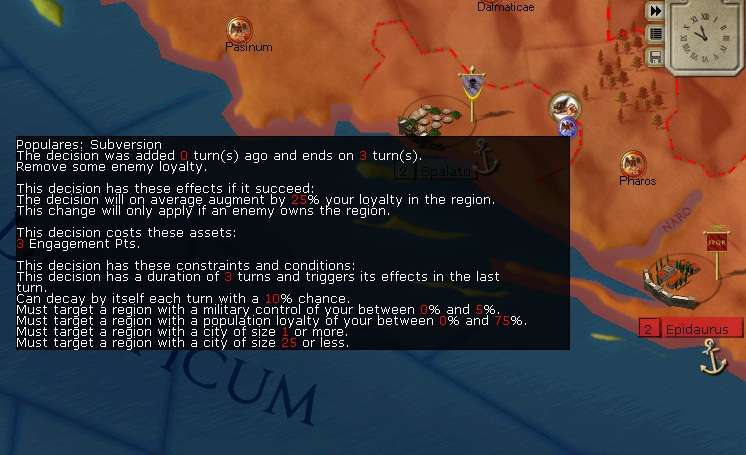
While we try to raise loyalty in Italy
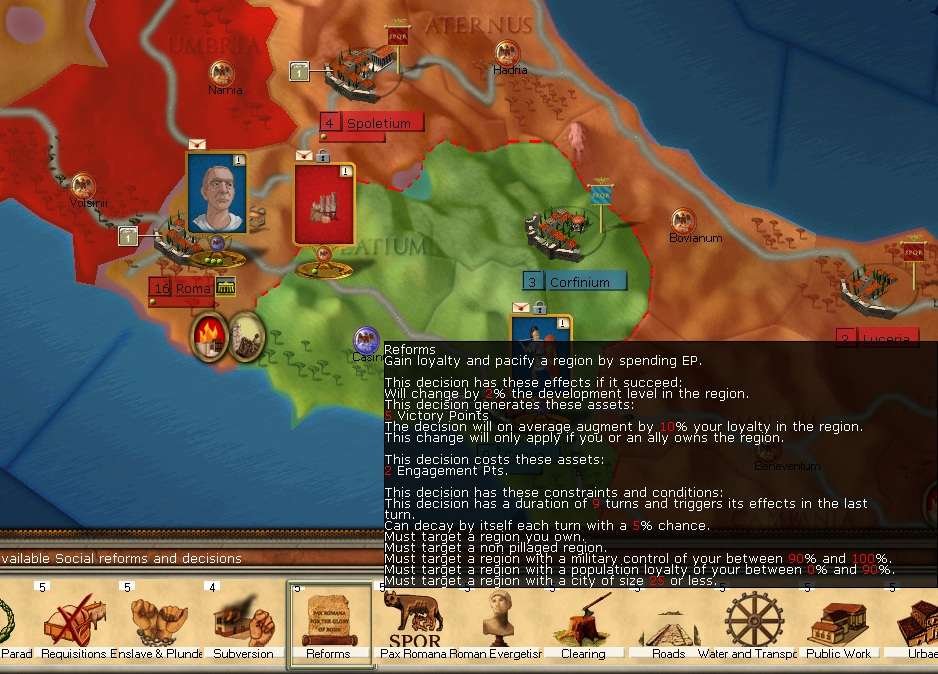
So in effect my orders are carry on with the sieges of Rome and Brundisium. Wait at Perugia till Cinna can join up with Marius. Run away in Spain and hope I can recruit some new legions before it all falls apart.
[1] – clearly outside it is wet and cold, however the cats have reached the point where even they cannot sleep any longer.
So, lets see where we are (actually under cat attack [1] irl, but that is not modelled in the game).
Well my attempt to relieve Corduba was a total disaster, but at least most of my army survived. They can retreat back to Ilipa and recover.


At Rome, Cinna did a decent job but still failed to take the city.

Marius in the meantime is watching the enemy at Ancona. I'll keep on the defense till Cinna has taken Rome.

At sea, someone was not paying attention.

I mean if a ship has a strange black and white flag you do not invite the crew on board for a nice drink and chance to look around.
I decide to buy a supply wagon for the legions besieging Brundisium. That should ensure they can take the city (which is otherwise an easy route back into Italy for Sulla)

And, yep, we'll have some more money thank you.

And lets have a look at the 'decisions'. Subversion sounds fun, lets try some of that over in Greece

While we try to raise loyalty in Italy

So in effect my orders are carry on with the sieges of Rome and Brundisium. Wait at Perugia till Cinna can join up with Marius. Run away in Spain and hope I can recruit some new legions before it all falls apart.
[1] – clearly outside it is wet and cold, however the cats have reached the point where even they cannot sleep any longer.
I think it was a very good idea to implement so much decisions (and events) as in RuS.
I agree: the events and decisions seem to add another layer or uncertainty and strategy, respectively. It just feels more 'alive', the world seems bigger compared to Wars in America.
I don't have a lot to say about the current events, but will say that I feel like I got the hang of Narwhal's Beginner's Corners! Reading all those AARs might actually pay off in a smoother transition to the actual game!
I don't have a lot to say about the current events, but will say that I feel like I got the hang of Narwhal's Beginner's Corners! Reading all those AARs might actually pay off in a smoother transition to the actual game!
@ Loki (and Narwhal I guess): The cost of the merchant option is zero....why not dump all the merchants somewhere at once? You run the risk they "decay", but that does not change during the game... the sooner you send them out, the longer they bring in money.... or do I miss something here?
@ Narwhal: What is your NM? Is it alreadydown to 95 or lower? Otherwise the bread and games campaign won't work as I understand it?
@ Narwhal: What is your NM? Is it alreadydown to 95 or lower? Otherwise the bread and games campaign won't work as I understand it?
@ Narwhal: What is your NM? Is it alreadydown to 95 or lower? Otherwise the bread and games campaign won't work as I understand it?
Similarly, I read in the 'get more money' option that it will only work if you have 150 denarii or less, while you have over 400.
Is that correct?
I think it was a very good idea to implement so much decisions (and events) as in RuS.
I agree: the events and decisions seem to add another layer or uncertainty and strategy, respectively. It just feels more 'alive', the world seems bigger compared to Wars in America.
I don't have a lot to say about the current events, but will say that I feel like I got the hang of Narwhal's Beginner's Corners! Reading all those AARs might actually pay off in a smoother transition to the actual game!
I'd agree with this. In the earlier AGE games the decisions/events are important but are also rare and equally there is usually no reason not to take them all. This gives a feel that there is a complex political/social tussle that you can engage in. At this stage what I'm struggling for is a feeling of value. Some look long term (and it may well be I won't survive till then), others its a case of judging best use - I really don't know if that 'lower loyalty' decision was best played in Narwhal's Greek provinces or in Italy? But its taken one of the most interesting bits of RUS and enhanced it, and in turn that will reduce the extent that there are standard strategies. As the game is played, and people share ideas, it'll be interesting to see how this works out.
In a couple of posts (maybe the next - not too sure) I start making use of some of the really hard line decisions, we're into forced requisitions (my logic is the Spanish are in revolt, well I'll take what I can on the way out) and political killings. At this stage you can see the trade-offs quite obviously.
@ Loki (and Narwhal I guess): The cost of the merchant option is zero....why not dump all the merchants somewhere at once? You run the risk they "decay", but that does not change during the game... the sooner you send them out, the longer they bring in money.... or do I miss something here?
@ Narwhal: What is your NM? Is it alreadydown to 95 or lower? Otherwise the bread and games campaign won't work as I understand it?
Excellent spot about the merchants. Have just loaded and checked. So the only limit is the number you have (5 in my case) to deploy. I'm not in the beta so no idea if that is WAD or an oversight - everything else has a price tag.
Similarly, I read in the 'get more money' option that it will only work if you have 150 denarii or less, while you have over 400.
Is that correct?
Yes, a few of my early choices were ill-judged, and a few such as the raise NM/raise money only work if you are already below (or above) a certain level. Think its one of those things that become second nature once you have played a bit but easy to overlook when doing so for the first time. At least its not like PoN where you sometimes need to work through 3-4 screens and tooltips trying to work out where to place something (one of the worst for this is placing the long term colonial merchant decision in PoN)
Damn you two! I was quite content to read the AAR but it looks so good I'm just going to have to buy the game.
*Wanders off to the AGEOD site with debit card clutched sweatily in hand
*Wanders off to the AGEOD site with debit card clutched sweatily in hand

